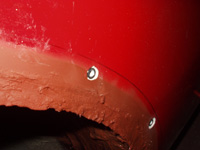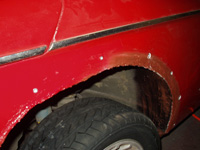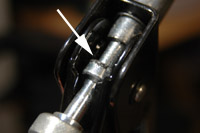To install my turbo-style fender flares I used a threaded insert tool (also referred to as a riv-nut, rivet-nut or threaded rivet) as opposed to pop-rivets or nuts and bolts. The threaded inserts are fed onto the rivet tool, pushed through a pre-drilled hole and then pressed into place. Squeezing the rivet gun bends and flanges the insert into the bodywork so that it is pinched in place and doesn’t move. Then you just simply screw in your bolt/screw and you are set.
The Harbor Freight Threaded Insert Riveter I purchased was a measly $13.99. However, it came with 40 threaded inserts and a couple interchangeable nose pieces allowing you to install multiple sized inserts. I also picked up an extra couple bags of inserts just in case I fudged it up a bit.
Once I had finished prepping, welding and sealing my fenders I marked where the holes needed to be drilled for the inserts. I chose the 10-24 inserts as they were larger and appeared to fit nicely with my flares. The bolts I used were purchased from a local fastener store. I went for the black allen head bolts in 10-24 x 1.5″…1″ length worked just fine too. [[EDIT]] Update: The black allen head bolts rusted quickly. Just surface rust, but I replaced them with new stainless steel ones from McMaster-Carr.
The How-To
The holes to be drilled need to be large enough to accommodate the inserts, but no so large that there is much play when the rivet is installed. Matching the back end of your drill bit to the outer diameter of the rivet should give you a good idea of where to start. Thread the insert onto the end of the rivet gun so that the flange is closest to the gun and the barrel of the rivet will enter the body work. Once you have the flange flat against the bodywork, give the handles a firm squeeze until you feel the rivet bend.
Warning – Subdue those manly hands
DO NOT gorilla grip the tool!!! (good advice in any situation) These cheap HF tools will bend, break or generally crap out if you over do it. This HF tool is no different. It doesn’t take much pressure to get the rivet to seat securely in the body. Of course I over did it a couple times and ended up bending part of the rivet gun. You can see in the pic below where the piston body of the riveter got a bit gouged up. It doesn’t effect the overall use of the gun that much, but it makes it more annoying when trying to unscrew the gun from a mounted rivet. If you do happen to screw up and over-squeeze a rivet or strip the thread the inserts can be drilled out fairly easily. These inserts are soft aluminum so be careful inserting and when drilling them out.
Conclusion
Considering the price of this tool and the inserts, I was very happy with the results. Higher end rivet guns of this type sell for well over $100. But if you are only going to use it once or twice every year, a $14 Chinese-made version is a much more attractive option. I used this tool to insert about 30+ inserts but by the last fender flare my lumbering meat hooks had managed to ding up the face of the piston just a bit. The tool is still completely usable, just slightly more annoying than it was when new. Also keep in mind that this tool could be used to install front air dams, small spoilers and maybe some types of trim. And the bolts can be easily removed, unlike pop-rivets that have to be drilled out. Good luck!




